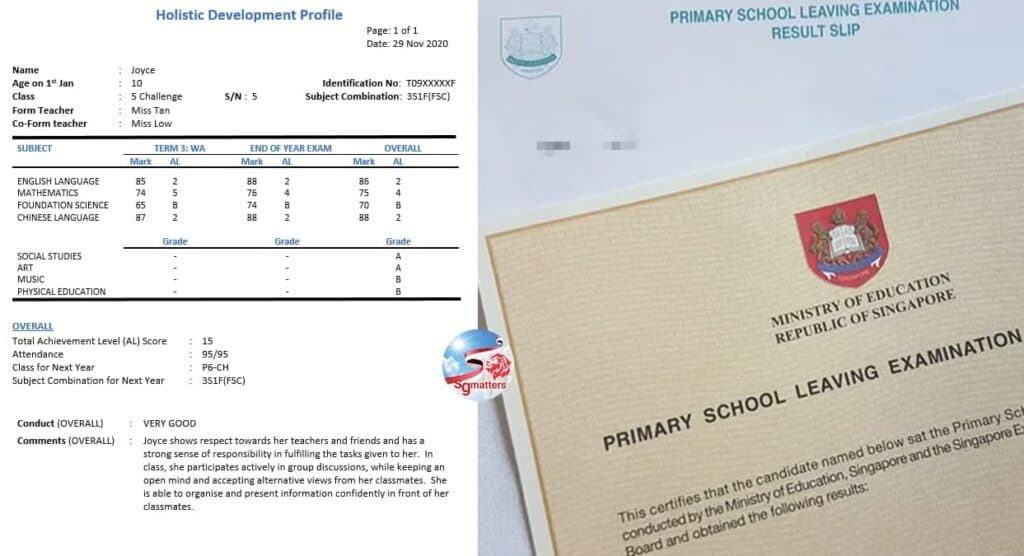Come next year, the new PSLE scoring and school placement system will kick in.
To help the first batch of students – the current P5 cohort – and parents familiarise themselves with the new scoring system, MOE has released the indicative Achievement Level (AL) Cut-Off Point (COP) ranges for different school types and the Subject-Based Banding (SBB) eligibility criteria under the AL scoring system.
Under this new PSLE scoring system, students will receive (Achievement Level) AL scores instead of T-scores. They will be graded based on their individual performance in the subjects, regardless of how their peers have done.
The new PSLE scoring system
Each PSLE subject will be scored using 8 Achievement Levels (ALs), with AL 1 being the best.
A student’s AL for each subject will reflect his/her own level of achievement.

Students taking Foundation level subjects
Students taking Foundational level subjects will be scored according to 3 achievement levels A, B and C.
Achievement level A is the equivalent of AL 6 for standard level subjects. B is the equivalent of AL 7 for standard level subjects, and C, the equivalent of AL 8.

Secondary School Placement
Admission to a secondary school and course is based on students’ overall PSLE performance.

What happens if there are two students with the same score vying for the last place in the same secondary school?
Tie-breakers for students with the same PSLE scores
Due to the wider scoring band, there will be more students with the same PSLE scores.
The following will be used as tie-breakers for students with the same PSLE scores.
1. Citizenship
2. Choice order of schools
3. Computerised balloting
School choice order is a new tie-breaker.
School choice order reflects the different considerations that students and parents have in making the choices such as a school’s ethos, culture, programmes and CCAs, as well as the distance between the school and a student’s home.
If there are two students with the same PSLE Score and same citizenship status vying for the last remaining place in a school, the student who ranked the school higher on his choice will be considered first.
Types of schools
Broadly speaking, there are three types of schools. These are: government and government-aided schools, autonomous schools and independent schools.
Government and Government-aided schools
These schools are the mainstay of our education system and offer high-quality education at standardised fees. They offer a range of electives, applied subjects and student development programmes.
Autonomous schools
These schools are a subset of Government or Government-aided schools mentioned above. Autonomous schools provide a wider range of programmes that seek to enhance students’ learning experiences and develop their talents.
Independent schools
These schools have the autonomy to develop their curriculum and programmes to cater to their students’ diverse learning needs.
Indicative Achievement Level (AL) Cut-Off Point (COP) Ranges for 2019 PSLE
The cut-off point for admission to a secondary school.

AL COPs may vary from year to year, depending on students’ PSLE results and their school choices for that year’s S1 Posting Exercise.
In the first half of 2021, MOE will provide the indicative AL COPs for individual secondary schools. This will be based on the PSLE results and school choices of the 2020 PSLE cohort. Students and parents can use this most recent data to guide them in their choice of schools.
Subject-based Banding eligibility criteria (Secondary)

Regardless of the academic course, a student enters in secondary school, the student will be eligible to take English Language, Mathematics, Science and/or Mother Tongue Language at the Express level, if the student scores AL 5 or better in a Standard level subject at the PSLE. The student will be eligible to take the subject at the N(A) level, if the student scores AL 6 or better at the Standard level or AL A at the Foundation level in that subject at the PSLE.
[irp posts=”4421″ name=”Two special education schools to redevelop and co-locate to serve special needs students”]
Going Forward
Beyond the start of Secondary 1, as students progress in secondary school, they will continue to have more opportunities to take subjects at more demanding levels based on their performance in school, to further pursue their strengths and develop to their fullest potential.





